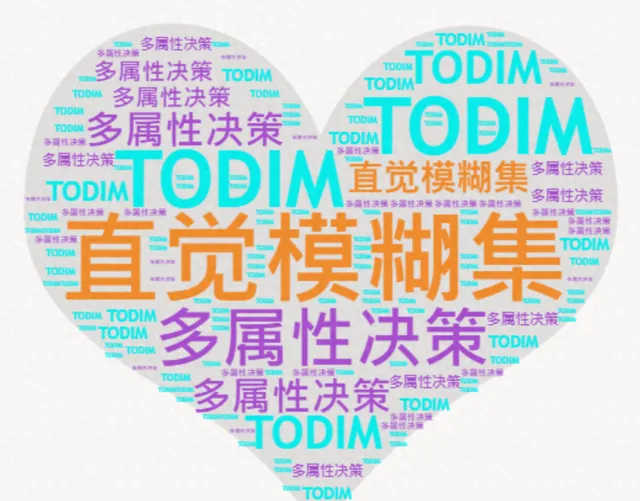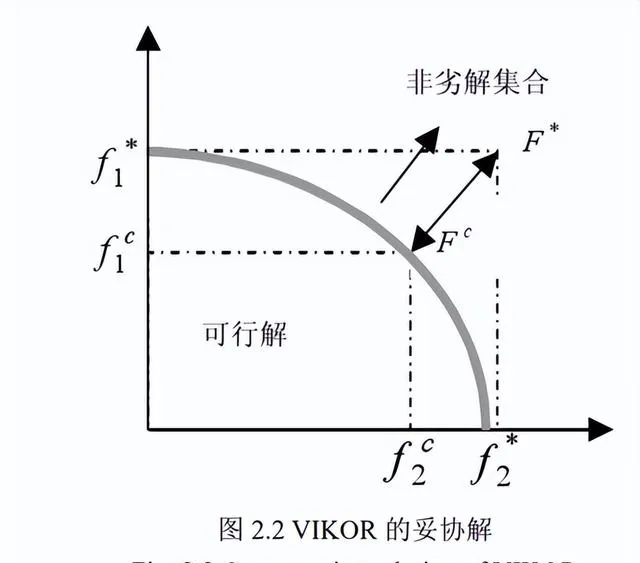
分享兴趣,传播快乐,增长见闻,留下美好!
亲爱的您,这里是LearningYard新学苑。
今天小编带你学习多属性决策知识,
欢迎您的访问!
Share interest, spread happiness,
increase knowledge, and leave beautiful.
Dear, this is the LearingYard Academy!
Today, the editor brings the 「Knowledge of multi-attribute decision-making」.
Welcome to visit!

VIOKR方法最早由前南斯拉夫的教授Opricavic在二十世纪90年代末提出的。该方法是一种在理想点法的基础上对最终排序进行了改进的方法,通过采用折衷的思想对多属性决策问题的研究进行优化。VIKOR方法的基本原理的第一步同TOPSIS方法的基本原理相类似,同样为获取正理想解以及负理想解,接下来进行折衷排序,依据为评价值与理想方案的距离。此方法的核心为不仅将群体效益值进行最大化处理,而且将个体遗憾值进行最小化处理,还能将决策者的个人偏好加到其中,因此决策者才能最终接受所求得的妥协解。在对方案的评价过程中,VIKOR方法里妥协折衷排序的思想利用了Lmetricp-聚合函数,该函数的测度描述如下:
The VIOKR method was first proposed by Professor Opricavic from former Yugoslavia in the late 1990s. This method is an improvement on the final ranking based on the ideal point method, which optimizes the research of multi-attribute decision-making problems by adopting a compromise approach. The first step in the basic principle of the VIKOR method is similar to that of the TOPSIS method, which is to obtain both positive and negative ideal solutions. Next, a compromise ranking is performed based on the distance between the evaluation value and the ideal solution. The core of this method is not only to maximize the group benefit value, but also to minimize the individual regret value, and to incorporate the decision-maker's personal preferences into it, so that the decision-maker can ultimately accept the compromise solution obtained. In the evaluation process of the scheme, the VIKOR method utilizes the Lmetric aggregation function with the compromise ranking idea, and the measurement description of this function is as follows:

VIKOR方法的妥协解图例为下图所示:
The compromise solution legend of the VIKOR method is shown in the following figure:

相关计算步骤如下所示:
步骤一:确定正负理想解
The relevant calculation steps are as follows:
Step 1: Determine positive and negative ideal solutions

第二步:计算各方案的群体效益值和个体遗憾值
Step 2: Calculate the group benefit value and individual regret value of each plan

步骤三:计算各方案的最终 VIKOR 值Qi 。
Step 3: Calculate the final VIKOR value Qi for each scheme.


其中Edi和EHi均为成本型变量,即变量的取值结果越小越好。Qi为第i个方案的综合评价值,Qi的取值越小方案越优。X1、X2Î [0,1]为决策系数,用来表示决策者的个人偏好度。若X1>X2时就表示决策者更加偏好于群体的观点,认为群体观点更重要;若X1<X2时就表示决策者更加偏好于个体遗憾度,认为个体观点更重要;若X1=X2= 0.5时表示决策者不存在明显的偏好情况。
Edi and EHi are both cost type variables, meaning that the smaller the value of the variable, the better. Qi is the comprehensive evaluation value of the i-th scheme, and the smaller the value of Qi, the better the scheme. X1, X2 Î [0,1] are decision coefficients used to represent the individual preferences of decision-makers. If X1>X2, it indicates that decision-makers are more inclined towards the perspective of the group and believe that the group perspective is more important; If X1<X2, it indicates that decision-makers are more inclined towards individual regret and believe that individual opinions are more important; If X1=X2=0.5, it indicates that the decision-maker does not have a clear preference situation.
第四步:分别根据所计算出的群体效益值Edi、个体遗憾值EHi和VIKOR值Qi对备选方案进行排序,得到三组序列排序表。
其中VIKOR的约束条件主要有两个:阈值和决策可靠度。
阈值公式为:

Step 4: Sort the alternative solutions based on the calculated group benefit value Edi, individual regret value EHi, and VIKOR value Qi, and obtain three sets of sequence sorting tables.
There are two main constraints for VIKOR: threshold and decision reliability.
The threshold formula is:

当有多个方案进行排序时,要将排在第一方案的 Q 值与排在第二、第三等方案的Q 值一一进行比较,看是否满足约束条件 1。该约束条件是为保证决策方案间具有较强 的显著性。
When there are multiple options for sorting, compare the Q values of the first option with those of the second, third, and other options one by one to see if constraint 1 is met. This constraint is to ensure strong saliency between decision options.
今天的分享就到这里了。
如果您对今天的文章有独特的想法,
欢迎给我们留言,
让我们相约明天,
祝您今天过得开心快乐!
That's all for today's sharing.
If you have a unique idea about the article,
please leave us a message,
and let us meet tomorrow.
I wish you a nice day!
参考资料:百度百科、百度翻译
参考文献:刘大林. 基于VIKOR方法的电商环境下供应商评价研究[D]. 沈阳工业大学, 2021.











